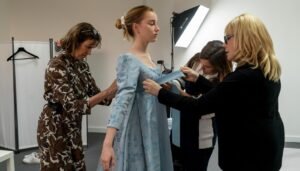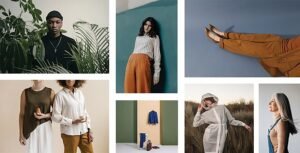Are you ready to immerse yourself in a world where art meets fashion? Step into the captivating universe of modeling, where every pose, runway strut, and photoshoot captures the essence of artistic expression. From the elegant arch of a back to the fierce gaze through the lens, join us as we explore the power behind modeling as an extraordinary form of art. Prepare to be mesmerized by the enchanting harmony between fashion and creativity that awaits around every corner. Welcome to a realm where poses transform into poetry, runways become stages for masterpieces, and photoshoots capture moments frozen in time – this is modeling at its finest!
Introduction to the connection between modeling and art
The art of modeling has been prominent in the fashion industry for decades, with models strutting down runways and posing for photoshoots to showcase designer collections. However, many people fail to recognize the deep connection between modeling and traditional forms of art such as painting and sculpture. In this section, we will delve into the intriguing relationship between modeling and art, exploring how it is a form of self-expression, a means of storytelling, and an embodiment of beauty.
One could argue that modeling is a modern form of performance art. Just like dancers or actors on stage, models have to convey a message through their body language while maintaining grace and poise. They must also be acutely aware of their surroundings – from the lighting to the set design – in order to create a visually appealing composition that tells a story. This level of precision requires skillful execution akin to that seen in traditional performing arts.
Moreover, like paintings or sculptures displayed in galleries or museums, models present themselves on runways or in photographs as pieces for an audience to admire. The way they carry themselves can evoke different reactions
The history of fashion and modeling as an art form

The art of fashion and modeling has a long and rich history, dating back to ancient civilizations. From elaborate costumes worn by gods and goddesses in Greek mythology to the extravagant outfits worn by royalty in the Renaissance era, clothing has always been used as a form of self-expression and social status. As society evolved, so did fashion and modeling, becoming integral parts of our cultural identity.
In the early 20th century, fashion photography emerged as a medium for showcasing designs and creating desire for certain styles. Photographers like Edward Steichen and Cecil Beaton captured the essence of fashion through their images, elevating it from mere clothing into an artistic expression. With the rise of magazines like Vogue and Harper’s Bazaar, fashion photography became a staple in mainstream media, influencing trends and shaping societal norms.
The 1970s saw another significant shift in the world of fashion when designers started incorporating avant-garde elements into their collections. This gave rise to unconventional forms of modeling that challenged traditional beauty standards. Models like Grace Jones became icons for their boldness and fearlessness
The power of poses and how they convey emotion and tell a story
When it comes to modeling, there is so much more than just looking pretty in front of a camera. It is an art form that requires skill, creativity, and the ability to convey emotion and tell a story through poses. The power of poses lies in their ability to capture the audience’s attention and evoke feelings within them.
Poses are not just about striking a specific position with your body; they are about conveying a message or telling a story. Each pose has its own unique energy and purpose, whether it’s fierce and confident or vulnerable and delicate. A model must understand the emotions behind each pose and how to bring them to life through their body language.
The power of poses also extends beyond photoshoots into runway shows. On the catwalk, models use their bodies as tools to convey different styles, moods, and attitudes that reflect the designer’s vision. Whether it’s strutting fiercely down the runway in high fashion or embodying grace and elegance for a couture collection – every step taken carries significance.
Runways as a platform for creativity and innovation in fashion
Runways have long been considered the ultimate platform for creativity and innovation in the fashion industry. It is on these elevated stages that designers can bring their visions to life, models can showcase their skills and grace, and photographers can capture the essence of it all. From New York to Paris, London to Milan, runways are where the latest trends are born and where fashion evolves.
At its core, fashion is an art form – a medium for self-expression, storytelling, and pushing boundaries. And runways provide the perfect canvas for this artistry to unfold. Designers use runways as a space to present their collections in a way that embodies their brand’s identity and vision. From avant-garde designs to more commercial pieces, runway shows allow designers to push the boundaries of what is possible in fashion.
For models, walking down a runway is more than just showing off clothes – it’s about embodying the designer’s vision through movement and expression. Models must be able to convey emotion through poses while showcasing garments from every angle. They become living sculptures on display as they bring each look to life with their own unique flair.
Photoshoots as a way to capture the essence of fashion

Photoshoots are a crucial aspect of the fashion industry and play a vital role in capturing the essence of fashion. It is through photoshoots that fashion designers, brands, and models are able to showcase their creations and express their artistic vision. These carefully curated images not only serve as visual representations of clothing but also convey emotions, tell stories, and inspire trends.
Moreover, photoshoots provide a platform for models to showcase their skills as artists. Modeling is not just about walking down a runway or posing in front of a camera; it is an expression of art. In photoshoots, models use different poses and facial expressions to convey emotions and bring the designer’s vision to life. They must be able to adapt quickly to various environments and embody different characters while still highlighting the outfit they are wearing.
Photoshoots also allow for experimentation with different concepts and themes. Fashion photography is not limited by any rules or boundaries – it is an opportunity for photographers, stylists, designers, and models to push creative boundaries and think
Read more:
Modeling as an Expression of Art: The Power of Poses, and Photoshoots
The impact of diversity in modeling and its role in promoting inclusivity in art
Diversity in modeling has become a hot topic in the fashion industry, with more and more people advocating for inclusivity and representation of all body types, races, genders, and ages. In recent years, there has been a noticeable shift towards diversity on runways, in photoshoots, and in advertising campaigns. This is not only a positive move towards promoting body positivity and breaking beauty stereotypes but also serves as an important step towards promoting inclusivity in art.
Furthermore, diversity in modeling allows for a wider audience to see themselves represented in the world of fashion. When people see others who look like them being featured as successful models or wearing high-end designer clothing on runways or in ads, it can have a profound impact on their self-esteem and confidence. It sends out a message that everyone is beautiful regardless of their size or appearance – something that many individuals struggle with due to societal pressure.
Moreover, featuring diverse models also adds depth and richness to the creative process behind fashion shoots and shows. Different cultures bring unique perspectives on style
How social media has changed the landscape of modeling as an art form
Social media has undoubtedly revolutionized the modeling industry, transforming it from a traditional and exclusive art form into a more inclusive and accessible platform for both models and audiences. The rise of social media platforms such as Instagram, Twitter, and TikTok has completely changed the landscape of modeling, providing new opportunities for models to express themselves creatively and connect with their audience in ways that were not possible before.
Moreover, social media has also given rise to a new type of model – the influencer. These are individuals who have built a significant following on social media through their unique sense of style, lifestyle choices, or talents. They often collaborate with brands to promote products or services through sponsored posts or partnerships. This merging of artistry and advertising has created new opportunities for brands to reach larger audiences while giving influencers creative freedom over how they want to represent themselves.
Another significant impact of social media on modeling is its ability to break down barriers between different forms of modeling. Traditional runway shows used to be limited only to high-end fashion weeks
Conclusion:
It is clear that modeling is much more than just posing in front of a camera or walking down a runway. It is truly an art form that requires creativity, skill, and dedication. The power of poses, runways, and photoshoots in the world of modeling cannot be underestimated.
Firstly, the use of poses in modeling allows for the expression of emotion and storytelling. Models are trained to convey a variety of emotions through their body language and facial expressions, creating powerful images that can captivate an audience. Whether it’s a fierce pose on the runway or a vulnerable look in a photoshoot, models have the ability to communicate without saying a single word.
Moreover, runways are not just platforms to showcase clothing but also stages for artistic expression. Fashion designers often use their collections to make statements about society or trends within culture. Models bring these designs to life on the runway with their movements and energy, adding depth and meaning to the clothes they wear.



